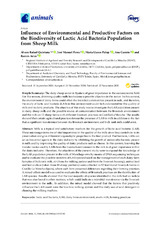Mostrar el registro sencillo del ítem
Influence of Environmental and Productive Factors on the Biodiversity of Lactic Acid Bacteria Population from Sheep Milk
| dc.contributor.author | Quintana, Álvaro Rafael | |
| dc.contributor.author | Perea Muñoz, José Manuel | |
| dc.contributor.author | Palop, María Llanos | |
| dc.contributor.author | Garzón Sigler, A. | |
| dc.contributor.author | Arias, Ramón | |
| dc.date.accessioned | 2020-11-23T10:59:37Z | |
| dc.date.available | 2020-11-23T10:59:37Z | |
| dc.date.issued | 2020 | |
| dc.identifier.uri | http://hdl.handle.net/10396/20783 | |
| dc.description.abstract | Milk is a typical and satisfactory medium for the growth of lactic acid bacteria (LAB). These microorganisms are of vital importance in the quality of the milk since they contribute to its preservation and give differential organoleptic properties to the final product. Furthermore, LABs can act as biocontrol agents in the dairy industry by inhibiting the growth of undesirable bacteria present in milk and by improving the quality of dairy products such as cheese. In this context, knowing the transfer routes used by LABs from the livestock environment to the milk is of great importance within the dairy industry. Therefore, the objectives of the present study were to expand the knowledge of the LAB population present in the milk of Manchego ewe by means of DNA sequencing techniques and to evaluate the possible transfers of LAB species based on the management of each dairy farm. Samples of bulk tank milk, air (from the milking parlour and from the livestock housing), animal feed and teat surface (taken from 10 sheep per farm) were collected in 12 traditional livestock farms in Castilla-La Mancha (Spain), where each farm presented differences regarding their farming practices. A mixed-effects model was used to evaluate the effects of livestock practices on the distribution of LAB species. Results showed that the vast majority of species identified in the milk had an isolate that was also found in other matrices, which could indicate a microbial transference via the livestock environment to the milk. In addition, the mixed model showed that the factors that positively influence the LAB count were the low-line milking system and the daily use of acid detergent in cleaning the milking machine. | es_ES |
| dc.format.mimetype | application/pdf | es_ES |
| dc.language.iso | eng | es_ES |
| dc.publisher | MDPI | es_ES |
| dc.rights | https://creativecommons.org/licenses/by/4.0/ | es_ES |
| dc.source | Animals 10(11), 2180 (2020) | es_ES |
| dc.subject | Lactic acid bacteria | es_ES |
| dc.subject | LAB | es_ES |
| dc.subject | Dairy farm environment | es_ES |
| dc.subject | Ewe’s milk | es_ES |
| dc.subject | Farming practices | es_ES |
| dc.title | Influence of Environmental and Productive Factors on the Biodiversity of Lactic Acid Bacteria Population from Sheep Milk | es_ES |
| dc.type | info:eu-repo/semantics/article | es_ES |
| dc.relation.publisherversion | http://dx.doi.org/10.3390/ani10112180 | es_ES |
| dc.relation.projectID | Gobierno de España. RTA2011-00057-C02-01 | es_ES |
| dc.rights.accessRights | info:eu-repo/semantics/openAccess | es_ES |

